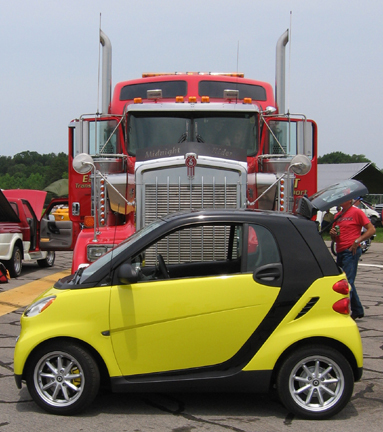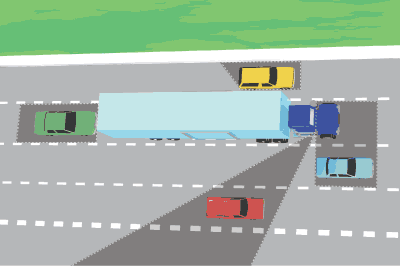Truckers Code
I’m sure you’ve heard the saying before, but it won’t hurt to say it again. Truckers are the backbone of this great nation. Everyday, we use things that are delivered by truckers without a second thought. Yet we often feel annoyed when we encounter these unsung heroes on the highway. Whether they’re passing too slowly or cutting us off, we’re too quick to curse out truckers. Next time, take a breath and think about what they have to deal with before becoming irate. After calming down and deciding not to pick a fight, use the truckers code to help them keep you safe.
Going
Many times on the open highway, I’ve been cut off by a big rig. Most of the time, I’m leaving a big gap in front of me for safety while everybody else is tailgating, and the trucker uses that gap to merge into my lane. Even though I’m usually going 10-20MPH faster than the truck is, it’s easy to let off the gas and move on afterwards.
Remember: your car is ~17 feet long and his rig is over 70 feet long. He doesn’t get many opportunities to get into another lane, so he’s going to take what he’s got. It’s also important for him to maintain momentum. After he moves out of my way, I’m going to push the gas pedal and get my 10-20MPH back in a matter of seconds. If he has to slow down 5MPH, it might take him several miles to get his speed back.
Stopping
If you were to try and cut him off for revenge, you’d be playing a losing game. A truck loaded to the 80,000lbs limit takes almost 1000 feet to stop from highway speed. Compare that with a typical 3500lb sedan, which can stop from 60 in just over 100 feet.
This does NOT mean that you can tailgate big rigs. It’s true that you can out-brake them, but that’s only if you see them brake in between texting and programming your GPS. Big rigs often have re-treaded tires that like to blow out. If you follow too closely, that tread and other debris could end up in your lap with a bunch of windshield glass in it.
Pulling Off
I used to wonder why truckers refused to pull to the side of the road and let me pass. That is, until the first time I towed a trailer. I realized that turnouts are impractical and usually aren’t designed for anything bigger than an RV. Many turnouts can’t physically accommodate a truck and trailer. Second, sometimes they are badly rutted which can damage precious cargo in the trailer. Beyond that, the trucker still has the issue of stopping in time and getting back up to speed. It’s simply not practical for them to risk pulling off to the side.
Blind Spots
It’s pretty well known that trucks have blind spots. These are areas that the mirrors can’t cover. You should never drive next to the trailer for extended periods of time, especially in the city where the trucks need several lanes to make turns. If you end up in the blind spots and the trucker tries to come into your lane with you still in it, you’re going to face a massive problem: the blind spot is both a visual and audible “blind” spot. You’re so far away from the trucker, and the driver is in such a loud environment (near the big diesel engine), that he is not likely to hear you honking your horn. That’s why trucks are equipped with extremely loud air horns. So if you see a trucker flip on his turn signal while you’re in his way, you’d better react fast!
Truckers Code
If you’ve seen the light and decide to be nice to truckers from now on, I’ll let you in on a little secret. Truckers communicate partially by using their lights.
- Truckers let each other know when it’s safe to merge into a lane by using their headlights – either turning them off (only if they were on to begin with), or by flashing their high beams.
- To say thanks for the above gesture, truckers will flick their trailer lights on and off, or use the hazard flashers.
Anybody can use these signals when you’re dealing with trucks. I often brake and give them room the moment I see them signal to come into my lane, followed by dousing my lights to let them know they’re welcome in. They appreciate this a lot, as you might imagine. Flashing high beams during the day can lead to confusion though – it can be misconstrued as “hey I’m not letting you in.” I also flash my hazard lights after passing a truck on a 2 lane road – it doesn’t hurt and it could put a smile on someones face.



